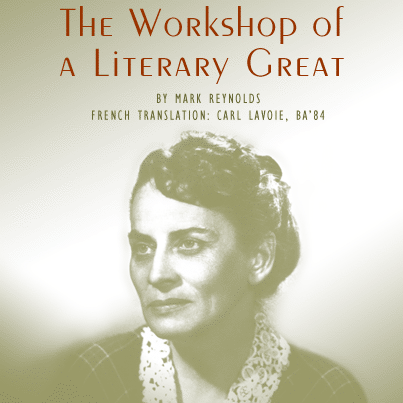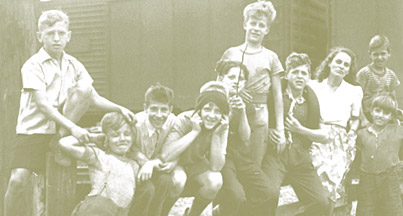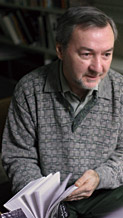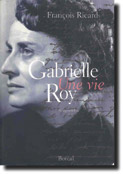
More than 20 years ago, François Ricard received the kind of gift that an ambitious young scholar might kill for. And he gave it away.
In the mid-1970s, Ricard had forged a friendship with Gabrielle Roy, one of Canada's greatest writers. Nearing the end of her life, Roy was becoming increasingly concerned with the disposition of her personal papers.
"One day, probably around 1980, she gave me her manuscript -- the manuscript of Enchantment and Sorrow, her great autobiography. She told me, 'you use this to write your biography, and then you publish it.' I had never told her that I would write her biography -- but she had that in her mind. I didn't say yes, but I didn't say no," recalled Ricard, the James McGill Chair of Quebec Literature.
In the end, he disobeyed the wishes of Roy, publishing her memoirs before writing his own prize–winning biography, Gabrielle Roy: A Life.

Born in St. Boniface, Manitoba, in 1909, Roy was the youngest of eight children (three other siblings did not survive), and the large family would live through financial difficulties after Roy's father, Léon, was laid off from his job with the federal government immigration department six months before he was to qualify for a pension, a victim of a change in the ruling federal party. Poverty would become a much revisited theme in Roy's work.
After finishing her schooling in Manitoba, Roy was able to find work as a teacher, even during the Great Depression, and her family was understandably startled when in 1937 she left a good job and Canada to study theatre in France and England. It was these two years in Europe where the first indications of her future as a writer emerged, as she published short articles in a French journal.
Upon her return to Canada in 1939 -- the threat of war precipitating her departure from Europe -- Roy was determined to become a writer, despite her mother's protestations. Settling in Montreal, she made a living as a freelance newspaper reporter and began working on the book that would bring her literary fame, Bonheur d'occasion. The novel was a success not just in Canada, where its English translation, The Tin Flute, won the Governor General's Award, but internationally, winning the Prix Fémina in Paris and the Literary Guild of America Award in the U.S. Over the next three and a half decades, book after book established Roy as one of the most celebrated postwar authors in Canada.
François Ricard's own definitive biography of Roy, published in 1996, is not, however, his last word on the great Franco-Manitoban author. Ricard is co-director (with French language and literature professor Jane Everett) of the Groupe de recherche sur Gabrielle Roy, which has been compiling, editing and publishing Roy's writing at a tremendous pace. The voluminous collection of personal papers Roy left behind, including numerous unpublished works, is now kept in the National Library of Canada in Ottawa. The material within provides an insight into the mind of the author of such classics as Bonheur d'occasion, Rue Deschambault (Street of Riches) and Alexandre Chenevert (The Cashier).
"She's considered one the most important Quebec and Canadian writers. We learn how she worked, what were her worries, how she changed her text from an earlier version to a final version. It's like entering the workshop of Gabrielle Roy," said Ricard.

Owen Egan
Ricard said that Roy has multiple readerships. Her fan base straddles French and English Canada, popular and academic culture. It is for this reason that English professor Nathalie Cooke is also a member of the group.
"As a researcher, I'm interested in Roy's role in the English-Canadian canon. Why did she earn such a central position when other French-Canadian writers did not? What is it about her work that makes it quite so compelling, even now?" said Cooke.
Cooke points out that Roy's The Tin Flute is considered to be the first Canadian novel to depict the lives of the urban poor. "She used realism to establish a sympathetic glance between narrator and subject," she said.
The Groupe de recherche sur Gabrielle Roy has 15 students along with Ricard, Everett, Cooke and Sophie Marcotte (a former student of Ricard's who is now a professor at Montreal's Concordia University), and may expand further. Together they have produced numerous collections of Roy's unpublished writing as well as their own research papers.
Such is the interest in Roy's work more than two decades after her death that these volumes continue to sell well. Mon cher grand fou -- a collection of correspondence between Roy and her husband, Marcel Carbotte, sold 5,000 copies. Bolder yet was the publication of Le temps qui m'a manqué, the sequel to Enchantment and Sorrow. That volume only covers Roy's life to 1939.
"She had intended to write her whole life, of course, but she was too ill. She published two parts in Enchantment and Sorrow, and she had started to write a third part, but only had time to do maybe 60 pages," Ricard said.

The finds in the National Library have forced academics to reconsider Roy's legacy. For instance, critics have noted her writing as being non- and even anti-feminist. Within her papers, however, are two unpublished novels that Ricard says paint a different picture.
"They revealed another Gabrielle Roy -- a Gabrielle Roy who was really concerned with the problems of the feminine condition. This was a dimension of her work and thought that was not really known before what we discovered," said Ricard.
Although Roy was educated in English, she chose to write in French. Her world straddled French and English Canada like no other writer of her time. And despite her notorious dislike of publicity, her network in the literary world has yielded a treasure trove of historical material.
"From her correspondence we can see that she was very aware of what was going on in the literary milieu, she was following these things very closely. I think that this can be a contribution to Quebec and Canadian literary history. She was such an important writer, such a central writer, that she had contact, through her correspondence, with almost every important writer in Quebec and Canada."
La Groupe du recherche sur Gabrielle Roy also organizes seminars on her work. One was on "Re-writing Gabrielle Roy": both her own self-editing and re-writing and her work in translation. Another was on Roy's effect on Montreal writers, which continues to this day. At that seminar, Ricard notes, many local writers they invited admitted that Roy has had a great impact on their own writing, and on Canadian literature as a whole. This is a mark of Roy's special allure.
"Usually when a writer dies there is a period of purgatory when they are forgotten, which lasts 15 to 20 years, and then they are rediscovered -- or not," adds Ricard. "This never happened with Gabrielle Roy."


